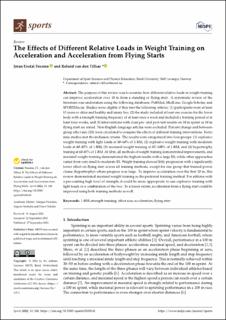| dc.contributor.author | Fossmo, Jøran Ersdal | |
| dc.contributor.author | van den Tillaar, Roland Johannes Wilhelmus | |
| dc.date.accessioned | 2023-02-08T14:51:44Z | |
| dc.date.available | 2023-02-08T14:51:44Z | |
| dc.date.created | 2022-11-03T14:02:54Z | |
| dc.date.issued | 2022 | |
| dc.identifier.citation | Fossmo, J. E. & van den Tillaar, R. (2022). The effects of different relative loads in weight training on acceleration and acceleration from flying starts. Sports, 10(10), Article 148. doi: | en_US |
| dc.identifier.issn | 2075-4663 | |
| dc.identifier.uri | https://hdl.handle.net/11250/3049418 | |
| dc.description.abstract | The purpose of this review was to examine how different relative loads in weight training can improve acceleration over 10 m from a standing or flying start. A systematic review of the literature was undertaken using the following databases: PubMed, MedLine, Google Scholar, and SPORTDiscus. Studies were eligible if they met the following criteria: (1) participants were at least 15 years or older and healthy and injury free, (2) the study included at least one exercise for the lower body with a strength training frequency of at least once a week and included a training period of at least four weeks, and (3) interventions with clear pre- and post-test results on 10 m sprint or 10 m flying start are stated. Non-English-language articles were excluded. Percent change and between-group effect size (ES) were calculated to compare the effects of different training interventions. Forty-nine studies met the inclusion criteria. The results were categorized into four groups: (1) explosive weight training with light loads at 30–60% of 1-RM, (2) explosive weight training with moderate loads at 60–85% of 1-RM, (3) maximal weight training at 85–100% of 1-RM, and (4) hypertrophy training at 60–85% of 1-RM. At 10 m, all methods of weight training demonstrated improvements, and maximal weight training demonstrated the highest results with a large ES, while other approaches varied from very small to moderate ES. Weight training showed little progression with a significantly lower effect on flying start across all training methods, except for one group that trained power cleans (hypertrophy) where progress was large. To improve acceleration over the first 10 m, this review demonstrated maximal weight training as the preferred training method. For athletes with a pre-existing high level of strength, it could be more appropriate to use explosive training with light loads or a combination of the two. To a lesser extent, acceleration from a flying start could be improved using both training methods as well. | en_US |
| dc.language.iso | eng | en_US |
| dc.publisher | MDPI | en_US |
| dc.rights | Navngivelse 4.0 Internasjonal | * |
| dc.rights.uri | http://creativecommons.org/licenses/by/4.0/deed.no | * |
| dc.title | The effects of different relative loads in weight training on acceleration and acceleration from flying starts | en_US |
| dc.type | Peer reviewed | en_US |
| dc.type | Journal article | en_US |
| dc.description.version | publishedVersion | en_US |
| dc.rights.holder | © 2022 The Authors | en_US |
| dc.source.pagenumber | 28 | en_US |
| dc.source.volume | 10 | en_US |
| dc.source.journal | Sports | en_US |
| dc.source.issue | 10 | en_US |
| dc.identifier.doi | 10.3390/sports10100148 | |
| dc.identifier.cristin | 2068665 | |
| dc.source.articlenumber | 148 | en_US |

